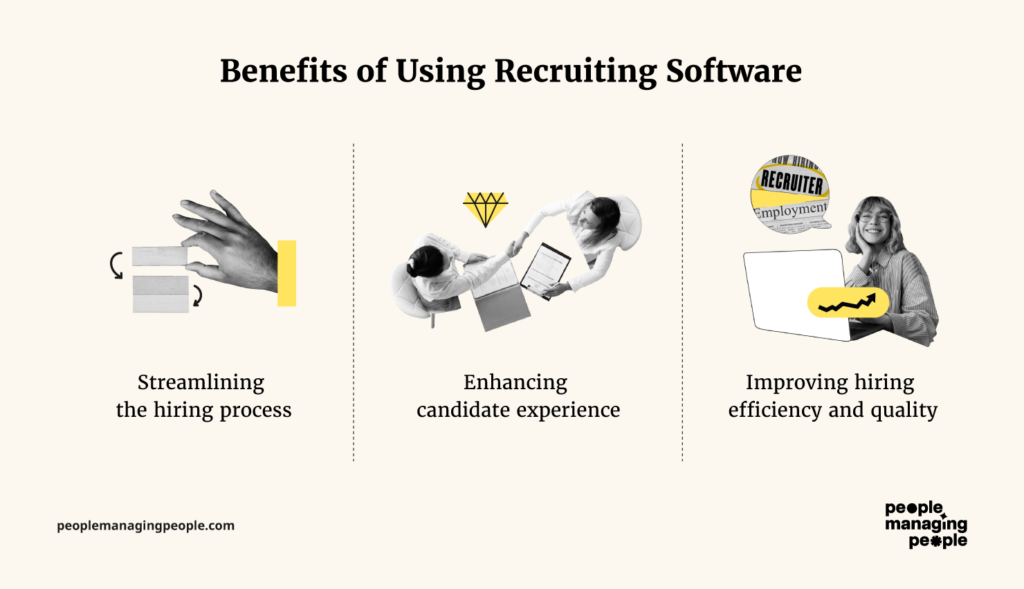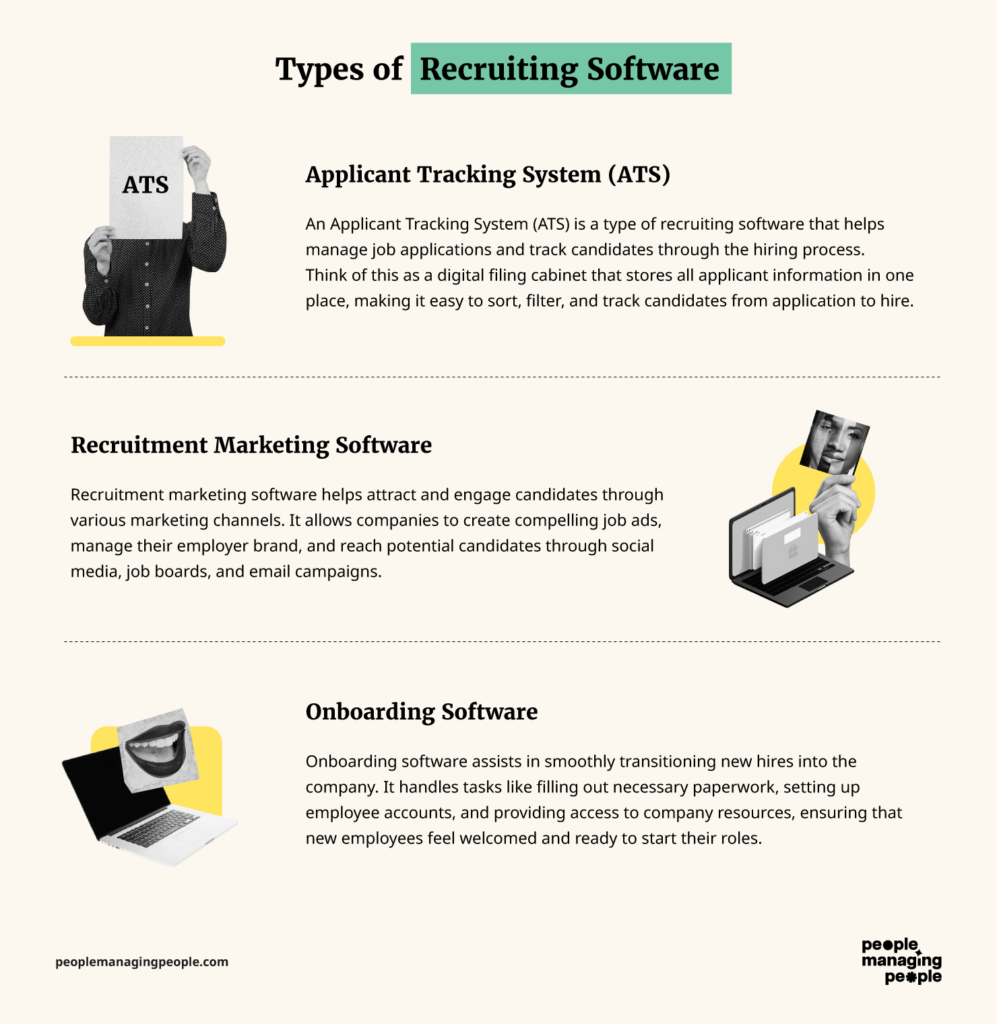Few things in life give more "searching for a needle in a haystack" vibes than recruiting.
You post a job opening, receive hundreds of resumes, and then the real challenge begins: sorting through them, scheduling interviews, and negotiating the offer.
This is where recruiting software can help make this process more efficient and enjoyable for everyone.
In this article, I’m going to provide an introduction to what you need to know about the tools that are going to shape your recruiting process.
What is Recruiting Software?
Recruiting software is a suite of tools designed to automate recruitment processes and streamline hiring.
From job postings to candidate onboarding, the software can handle various tasks to make the recruitment process more efficient and effective.
Through an extensive array of features, it helps hiring teams manage the entire recruitment process, ensuring that they find the best available candidates.
Benefits of Using Recruiting Software
If you were going to actually search for a needle in a haystack, you’d at least want a pitchfork to help you sort through it. When it comes to recruiting, the software you choose is your pitchfork and it has some significant benefits that come with it. Recruitment software benefits include:

Streamlining the hiring process
Imagine having a personal assistant who handles all the mundane tasks involved in hiring. That's essentially what recruiting automation software can do for you. It can automate everything from job postings to resume screening.
You can post a job on multiple platforms with just one click, and the software will track the applications as they come in. This saves time and reduces the risk of overlooking a potential star candidate.
Enhancing candidate experience
Communication is key in recruitment. Candidates often feel anxious when they don't hear back promptly and start to assume the worst.
Recruiting software can send automated updates to candidates, letting them know where they stand in the hiring process. This keeps candidates informed and engaged, leaving a positive impression of your company.
Improving hiring efficiency and quality
Finding the right candidate efficiently can drive down costs and help you maintain or improve productivity.
Recruiting software uses advanced algorithms to match job requirements with candidate qualifications, reducing the time-to-hire.
It also helps identify high-quality candidates by analyzing data from resumes, social profiles, and previous job performances, ensuring you make the best hiring decisions and streamline your overall recruiting strategy.
Who Uses Recruiting Software?
Recruiting software is used by a wide range of organizations, from small startups to large enterprises.
HR departments, hiring managers, and recruitment agencies all benefit from these tools to streamline their hiring processes and improve the quality of their hires.
Some native apps still exist, but most are cloud-based recruiting solutions.
Types of Recruiting Software
The tools that are available to help you solve your recruiting woes tend to be fairly robust, but they may also focus on specific aspects of the recruiting process. Here are some examples.

Applicant Tracking Systems (ATS)
An applicant tracking system is a type of recruiting software that helps manage job applications and track candidates through the hiring process.
Think of this as a digital filing cabinet that stores all applicant information in one place, making it easy to sort, filter, and track candidates from application to hire.
Key ATS features include automated job posting tools, applicant tracking (obviously), automated interview scheduling and reminders, recruitment analytics and reporting, and interview scheduling tools.
Recruitment Marketing Software
Recruitment marketing software helps attract and engage candidates through various marketing channels.
It allows companies to create compelling job ads, manage their employer brand, and reach potential candidates through social media, job boards, and email campaigns.
Onboarding Software
Onboarding software assists in smoothly transitioning new hires into the company. It handles tasks like filling out necessary paperwork, setting up employee accounts, and providing access to company resources, ensuring that new employees feel welcomed and ready to start their roles.
Pro tip: Free recruiting platforms can simplify the hiring process by automating candidate tracking and communication without incurring costs.
Key Features of Recruiting Software
Most recruiting software comes with a variety of features designed to make the hiring process more efficient:
- Applicant Tracking: Manages and tracks job applications.
- Job Posting: Allows posting to multiple job boards and social media platforms.
- Resume Parsing: Automatically extracts information from resumes for easy comparison.
- Interview Scheduling: Often automated to free hiring managers from this task.
- Analytics: Provides data and insights to improve the hiring process and establish meaningful recruiting metrics.
- Resume screening: Resume screening software modules help parse high volumes of applicants.
Challenges of Implementing Recruiting Software
While recruiting software offers many benefits, implementing it can come with challenges. These might include:
- Cost of recruiting software
- Training staff to use it effectively
- Integrating recruiting software with existing systems.
Despite these challenges, GoHire estimates that 89% of large companies use a tool such as an ATS, while 36% of small to medium size companies do.
If you use a recruiting agency to help you fill a role, roughly 75% of them use some type of staffing software solution to help them source and hire candidates.
Why? Because the long-term benefits usually outweigh these initial hurdles and change processes to support scaling a business and protecting HR professionals’ time.
How to Choose the Right Recruiting Software
If you’re thinking of investing in recruiting software, it’s best not to rush into anything and instead go through a process of establishing what problem you are trying to solve, and what your ideal world with recruiting software looks like.
Assessing Your Needs
Before selecting recruiting software, evaluate your organization's specific needs. Consider the size of your company, the volume of hiring, and the specific challenges you face in your recruitment process.
Ask yourself a couple of important questions:
- Are there industry-specific needs or compliance demands that the software has to be capable of meeting?
- Is this a tool that can support our hiring goals for the next 3-5 years?
- What features of recruiting software are most important to us?
- What is our timeline for purchase?
- How complicated will it be for the organization to implement recruiting software and integrate it with existing tools in your tech stack?
The answers to these questions will help you determine if your organization truly needs a tool, and if so, how robust a tool is necessary. It’ll also help you see more clearly how ready the organization is to adopt it.
Key Factors to Consider
When choosing recruiting software, keep the following factors in mind:
- Ease of Use: The software should be user-friendly.
- Scalability: It should be able to grow with your company's needs e.g. high-volume recruiting periods.
- Integration Capabilities: Ensure it can integrate with your existing HR systems.
- Cost: Consider your budget and the software's return on investment.
Frequently Asked Questions
What is the difference between an ATS and recruiting software?
An ATS is a type of recruiting software focused on managing and tracking applications. Recruiting software is a broader term that includes ATS along with tools for job posting, resume parsing, and more.
How much does recruiting software cost?
The cost of recruiting software varies widely depending on the features and the number of users. It can range from a few hundred dollars per month for small businesses to several thousand for larger enterprises.
Can small businesses benefit from recruiting software?
Absolutely. Recruiting software can save small businesses time and resources, helping them compete with larger companies in attracting top talent.
If you’re in the market for better tools to help your hiring team, our list of the best recruitment software for small businesses is a great place to start.
Recruiting software: is a powerful tool that can transform your hiring process.
By automating tasks: improving communication, and leveraging data, it helps you find the best candidates faster and more efficiently.
Whether you're a small business or a large corporation: investing in recruiting software can provide significant returns.
Want to learn more about how technology is impacting the practice of recruiting? Sign up for the People Managing People newsletter and get all the latest updates, insights, and trends from the world of recruiting.




